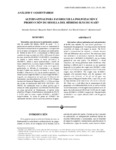
Please use this identifier to cite or link to this item:
http://ricaxcan.uaz.edu.mx/jspui/handle/20.500.11845/921Full metadata record
| DC Field | Value | Language |
|---|---|---|
| dc.contributor.other | 0000-0001-7861-4780 | es_ES |
| dc.coverage.spatial | Global | es_ES |
| dc.creator | Espinosa, Alejandro | - |
| dc.creator | Tadeo, Margarita | - |
| dc.creator | Medina, Hortencia | - |
| dc.creator | Gutierrez, José Ricardo | - |
| dc.creator | Luna Estrada, Maximino Gerardo | - |
| dc.date.accessioned | 2019-04-03T16:33:50Z | - |
| dc.date.available | 2019-04-03T16:33:50Z | - |
| dc.date.issued | 2001 | - |
| dc.identifier | info:eu-repo/semantics/publishedVersion | es_ES |
| dc.identifier.issn | 2215-3608 | es_ES |
| dc.identifier.uri | http://ricaxcan.uaz.edu.mx/jspui/handle/20.500.11845/921 | - |
| dc.description | Alternatives to favor pollination and seed production of H-311 corn hybrid. For corn hybrid production it is fundamental that progenitors’ flowering coincide and that the availability of stigma with respect to tassels. The H-311 hybrid is recommended for irrigated, at altitudes between 1200 and 1800 meters above sea level. The initial cross order was: (B16XB17) X (B32XB33); however, the order was reversed, that is (B32XB33) X (B16XB17), due to a higher productivity and seed quality. The B16XB17 is dwarf (braquitic), and during pollination under insufficient wind, breeding is difficult and it is necessary to use motorized knapsacks to rise pollen, the simple cross B16XB17, yields from 4.5 to 5.5 t/ha of seed, compared to 6.0 to 7.5 t/ha of the simple cross B32XB33; The simple cross B16XB17, responds with increased height with the treatment with giberelic acid (Activol), at 20, 40 and 60 ppm, two applications of Meqiquat Chloride (PIX), 1 and 2 l/ha, as well as three fertilizer levels (400-70-30, 150-70-30 y 150-300- 30). There was a yield effect due to management of both progenitors with different fertilizer levels, as well as with the use of fitohormones, with the application of giberelic acid (20 ppm), the yield increased 250.3%and 211.8% for the simple crosses B32XB33 y B16XB17, respectively. The plant height of B16XB17 was slightly affected (106% with 40 ppm of giberelic acid). | es_ES |
| dc.description.abstract | Alternativas para favorecer la polinización y producción de semilla del híbrido H-311 de maíz. En la producción de semilla de híbridos de maíz es fundamental la coincidencia en floración de los progenitores y la disposición de los estigmas con respecto a las panojas que emiten polen. El híbrido de maíz H-311, se recomienda en México para siembras de riego, en alturas de 1200 a 1800 msnm. El orden de cruza inicial fue: (B16XB17) X (B32XB33); sin embargo, se cambio al orden inverso, es decir, (B32XB33) X (B16XB17), debido a mayor productividad y semilla de buena calidad física. La cruza simple (B16XB17) es enana (braquítico), al no haber suficiente viento en la época de polinización, se dificulta el cruzamiento y se requiere levantar el polen con mochilas de motor, la cruza simple B16XB17, rinde de 4,5 a 5,5 t/ha de semilla contra 6,0 a 7,5 t/ha de la cruza simple B32XB33; La cruza simple B16XB17, responde con alargamiento del porte por la influencia del tratamientos, con ácido giberélico (Activol), 20, 40 y 60 ppm, dos dosis de Cloruro de Mepiquat (PIX), 1 y 2 lt/ha, así como tres niveles de fertilización (400-70-30, 150-70-30 y 150- 300-30). En rendimiento hubo un efecto positivo por el manejo de ambos progenitores con diferentes fertilizaciones así como aplicación de fitohormonas, al aplicar ácido giberélico (20 ppm), el rendimiento se incrementó en 250,3% y 211,8% para las cruzas simples B32XB33 y B16XB17 respectivamente. La altura de planta de B16XB17 fue ligeramente afectada (106,0% con ácido giberélico, 40 ppm). | es_ES |
| dc.language.iso | spa | es_ES |
| dc.publisher | Universidad de Costa Rica | es_ES |
| dc.relation.uri | generalPublic | es_ES |
| dc.rights | Atribución-NoComercial-CompartirIgual 3.0 Estados Unidos de América | * |
| dc.rights.uri | http://creativecommons.org/licenses/by-nc-sa/3.0/us/ | * |
| dc.source | Agronomía Mesoamericana, Vol. 12, No. 2, 2001, pp. 229-235 | es_ES |
| dc.subject.classification | CIENCIAS AGROPECUARIAS Y BIOTECNOLOGIA [6] | es_ES |
| dc.subject.other | polinización | es_ES |
| dc.subject.other | híbridos de maíz | es_ES |
| dc.subject.other | siembras de riego | es_ES |
| dc.title | Alternativas para favorecer la polinización y producción de semilla del Híbrido H-311 de maíz | es_ES |
| dc.type | info:eu-repo/semantics/article | es_ES |
| Appears in Collections: | *Documentos Académicos*-- UA de Agronomía | |
Files in This Item:
| File | Description | Size | Format | |
|---|---|---|---|---|
| Alternativas para favorecer la polinización.pdf | 101,64 kB | Adobe PDF |  View/Open |
This item is licensed under a Creative Commons License
